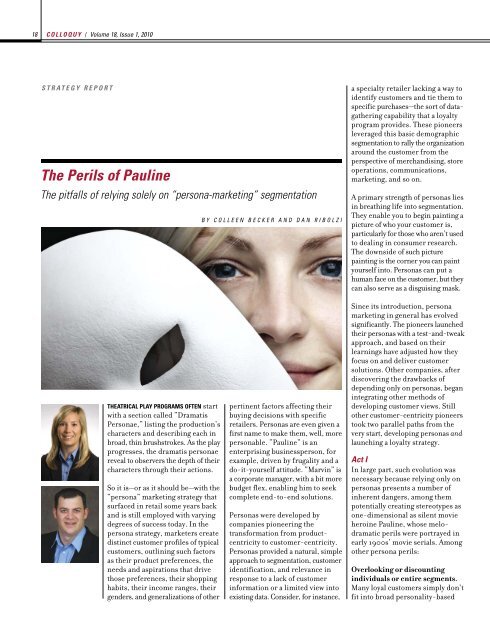Transformers - Colloquy
Transformers - Colloquy
Transformers - Colloquy
You also want an ePaper? Increase the reach of your titles
YUMPU automatically turns print PDFs into web optimized ePapers that Google loves.
18<br />
C O L L O Q U Y / Volume 18, Issue 1, 2010<br />
S T R A T E G Y R E P O R T<br />
The Perils of Pauline<br />
The pitfalls of relying solely on “persona-marketing” segmentation<br />
THEATRICAL PLAY PROGRAMS OFTEN start<br />
with a section called “Dramatis<br />
Personae,” listing the production’s<br />
characters and describing each in<br />
broad, thin brushstrokes. As the play<br />
progresses, the dramatis personae<br />
reveal to observers the depth of their<br />
characters through their actions.<br />
So it is—or as it should be—with the<br />
“persona” marketing strategy that<br />
surfaced in retail some years back<br />
and is still employed with varying<br />
degrees of success today. In the<br />
persona strategy, marketers create<br />
distinct customer profiles of typical<br />
customers, outlining such factors<br />
as their product preferences, the<br />
needs and aspirations that drive<br />
those preferences, their shopping<br />
habits, their income ranges, their<br />
genders, and generalizations of other<br />
B Y C O L L E E N B E C K E R A N D D A N R I B O L Z I<br />
pertinent factors affecting their<br />
buying decisions with specific<br />
retailers. Personas are even given a<br />
first name to make them, well, more<br />
personable. “Pauline” is an<br />
enterprising businessperson, for<br />
example, driven by frugality and a<br />
do-it-yourself attitude. “Marvin” is<br />
a corporate manager, with a bit more<br />
budget flex, enabling him to seek<br />
complete end-to-end solutions.<br />
Personas were developed by<br />
companies pioneering the<br />
transformation from productcentricity<br />
to customer-centricity.<br />
Personas provided a natural, simple<br />
approach to segmentation, customer<br />
identification, and relevance in<br />
response to a lack of customer<br />
information or a limited view into<br />
existing data. Consider, for instance,<br />
a specialty retailer lacking a way to<br />
identify customers and tie them to<br />
specific purchases—the sort of datagathering<br />
capability that a loyalty<br />
program provides. These pioneers<br />
leveraged this basic demographic<br />
segmentation to rally the organization<br />
around the customer from the<br />
perspective of merchandising, store<br />
operations, communications,<br />
marketing, and so on.<br />
A primary strength of personas lies<br />
in breathing life into segmentation.<br />
They enable you to begin painting a<br />
picture of who your customer is,<br />
particularly for those who aren’t used<br />
to dealing in consumer research.<br />
The downside of such picture<br />
painting is the corner you can paint<br />
yourself into. Personas can put a<br />
human face on the customer, but they<br />
can also serve as a disguising mask.<br />
Since its introduction, persona<br />
marketing in general has evolved<br />
significantly. The pioneers launched<br />
their personas with a test-and-tweak<br />
approach, and based on their<br />
learnings have adjusted how they<br />
focus on and deliver customer<br />
solutions. Other companies, after<br />
discovering the drawbacks of<br />
depending only on personas, began<br />
integrating other methods of<br />
developing customer views. Still<br />
other customer-centricity pioneers<br />
took two parallel paths from the<br />
very start, developing personas and<br />
launching a loyalty strategy.<br />
Act I<br />
In large part, such evolution was<br />
necessary because relying only on<br />
personas presents a number of<br />
inherent dangers, among them<br />
potentially creating stereotypes as<br />
one-dimensional as silent movie<br />
heroine Pauline, whose melo -<br />
dramatic perils were portrayed in<br />
early 1900s’ movie serials. Among<br />
other persona perils:<br />
Overlooking or discounting<br />
individuals or entire segments.<br />
Many loyal customers simply don’t<br />
fit into broad personality-based




